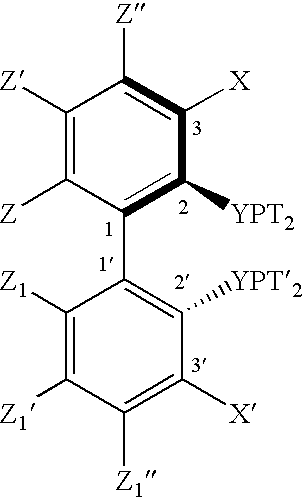Ortho substituted chiral phosphines and phosphinites and their use in asymmetric catalytic reactions
a technology of phosphinites and phosphines, which is applied in the direction of organic compounds/hydrides/coordination complexes, organic compounds/chemical process catalysts, organic compounds/chemical process catalysts, etc., can solve the problems of ineffectiveness and ineffectiveness of asymmetric hydrogenation reactions
- Summary
- Abstract
- Description
- Claims
- Application Information
AI Technical Summary
Benefits of technology
Problems solved by technology
Method used
Image
Examples
example 1
Synthesis of a 3,3′-Disubstituted Chiral BINOL (10b)
(R)-2,2′-Bismethoxymethoxy-1,1′-binaphthyl
To a THF (200 ml) solution of NaH (5.52 g, 230 mmol) was added (R)-BINOL (28.6 g, 100 mmol) Solution in THF (50 ml) under nitrogen at zero temperature, after 30 min. chloromethyl methyl ether (17.09 ml. 225 mmol) in 30 ml THF was added dropwise. The mixture was stirred overnight at room temperature. 3 ml water was added carefully to destroy the excess NaH, and filtered to remove the inorganic salt. The solution was passed a silica gel plug (hexane / ethyl acetate=1 / 1) to give pure product (97% yield).
(R)-3,3′-diiodo-2,2′-Bismethoxymethoxy-1,1′-binaphthyl
To a solution of (R)-2,2′-Bismethoxymethoxy-1,1′-binaphthyl (37.4 g, 100 mmol) in diethyl ether (400 ml) was added n-BuLi (100 ml, 2.5 M in hexane, 250 mmol) at room temperature under nitrogen, the mixture was stirred for 3 hours, then was cooled to 0° C., 200 ml THF was added, after 10 min, a solution of iodine (300 mol, 76.2 g) in THF (60 ...
example 2
Alternative Route for the Synthesis of a 3,3′-Disubstituted Chiral BINOL (10b)
(S)-2,2′-Dimethoxy-1,1′-dinaphthyl
To a solution of (S)-2,2′-dihydroxy-1,1′-dinaphthyl (10 g, 349.7 mmol) in 1000 ml 95% EtOH was added dimethyl sulfate (93.1 ml, 981.7 mmol, 2.8 eq.) and followed by dropwise addition of a solution of NaOH (175 g) in 300 ml H2O. After the addition, the resulting system was heated to reflux for 3 h, and then cooled. The reaction mixture was filtered, the precipitate was collected and washed with 10% aqueous NaOH (3×150 ml), and recrystallized from toluene (reflux to dissolve into 700 ml toluene, then let it stay at 0° C. overnight) to yield 84.1 g white crystal product (S)-2,2′-dimethoxy-1,1-dinaphthyl (yield=76.6%). 1H-NMR (CDCl3):δ7.985(d, J=9.0 Hz, 2H, Ar—H), 7.875(d, J=8.1 Hz, 2H, Ar—H), 7.468(d, J=9.0 Hz, 2H, Ar—H), 7.300˜7.326(t, 2H, Ar—H), 7.199˜7.218(t, 2H, Ar—H). 7.118(d, J=8.1 Hz, 2H, Ar—H), 3.773(s, 6H, —OCH3).
(S)-3,3′-Bis(dihydroxyborane)-2,2′-Dimethoxy-1,1′-dina...
example 3
Synthesis of a 3,3′-Disubstituted Chiral Phosphinite, (R)-3,3′-diphenyl-2,2′-bisdiphenylphosphinooxy-1,1′-binaphthyl (11b)
To a solution of (R)-3,3′-diphenyl-1,1′-binaphthol (876 mg, 2 mmol) in 20 ml THF at −78° C. was added n-BuLi (2.8 ml, 4.5 mmol) dropwise, the mixture was warmed to room temperature and stirred for 30 min, then cooled to −78° C., Ph2PCl (0.9 ml, 5 mmol) was added via syringe, then warmed to room temperature and stirred overnight. The THF was removed under reduced pressure, the residue was purified by basic Al2O3 (EtOAc / Hexane / Et3N=90 / 8 / 2) to give pure product (1.41 g. 87% yield).
1H-NMR (CD2Cl2, 360 MHz) 6.80-7.20 (m, 24H), 7.35-7.48 (m, 12H), 7.50-7.65 (m, 4H).). 31P-NMR (CD2Cl2, 360 MHz) 112.78.). 13C-NMR (CD2Cl2, 360 MHz) 124-150 (m). [α]D20=114.7 (c, 0.38, CHCl3). MS: 203 (100), 387 (65), 439 (48), 807 (50). HRMS C56H41O2P2 807.2566 Cal.: 807.2582.
PUM
| Property | Measurement | Unit |
|---|---|---|
| optical purity | aaaaa | aaaaa |
| optical purity | aaaaa | aaaaa |
| temperature | aaaaa | aaaaa |
Abstract
Description
Claims
Application Information
 Login to View More
Login to View More - R&D
- Intellectual Property
- Life Sciences
- Materials
- Tech Scout
- Unparalleled Data Quality
- Higher Quality Content
- 60% Fewer Hallucinations
Browse by: Latest US Patents, China's latest patents, Technical Efficacy Thesaurus, Application Domain, Technology Topic, Popular Technical Reports.
© 2025 PatSnap. All rights reserved.Legal|Privacy policy|Modern Slavery Act Transparency Statement|Sitemap|About US| Contact US: help@patsnap.com



